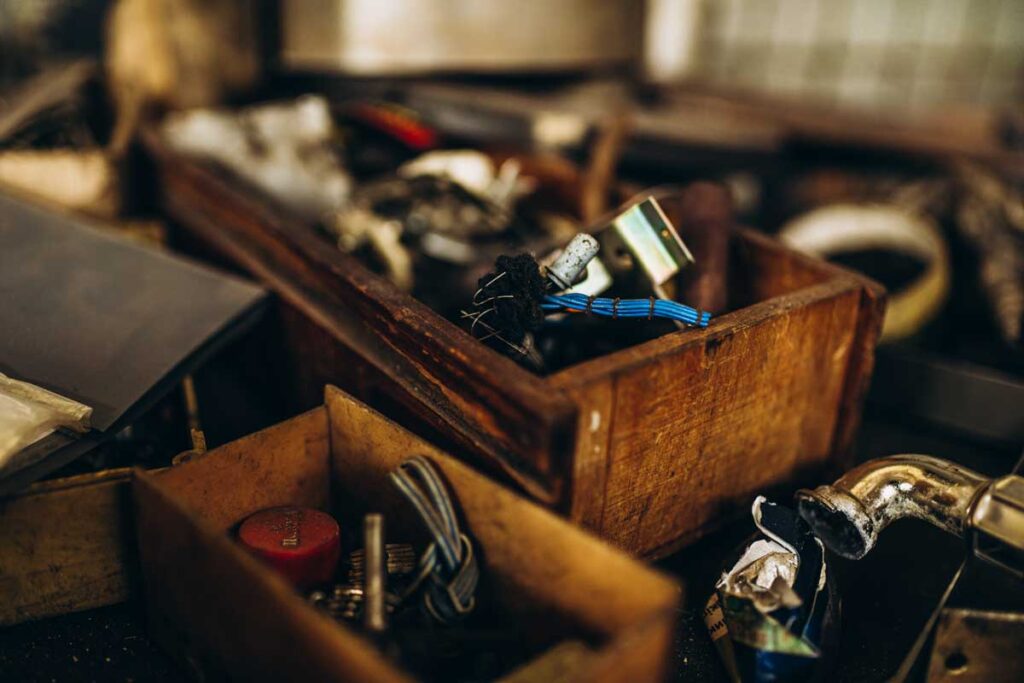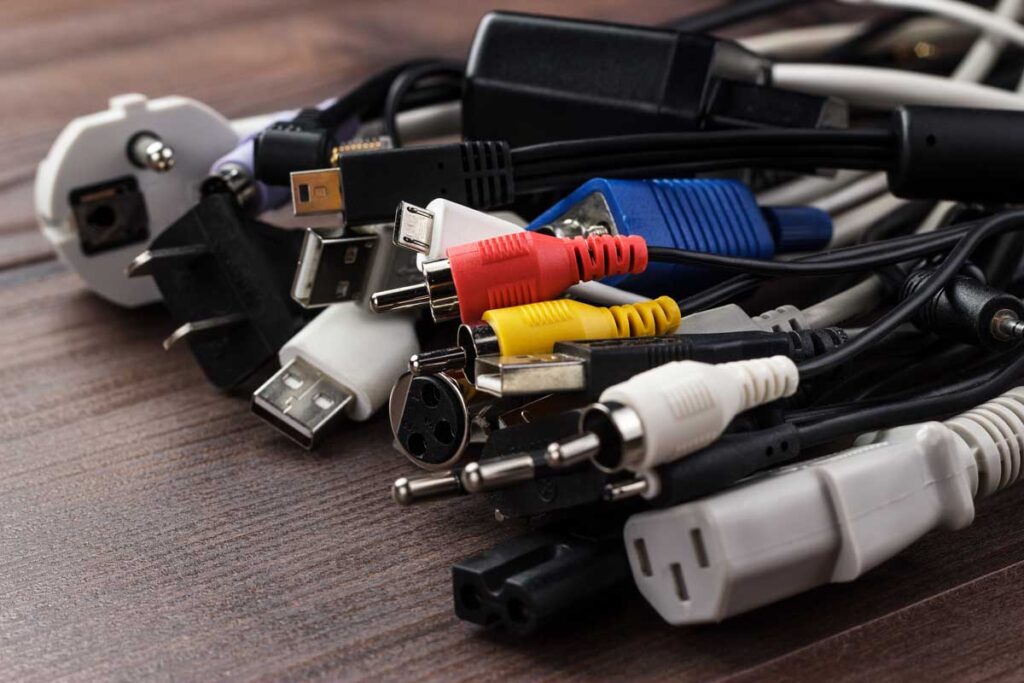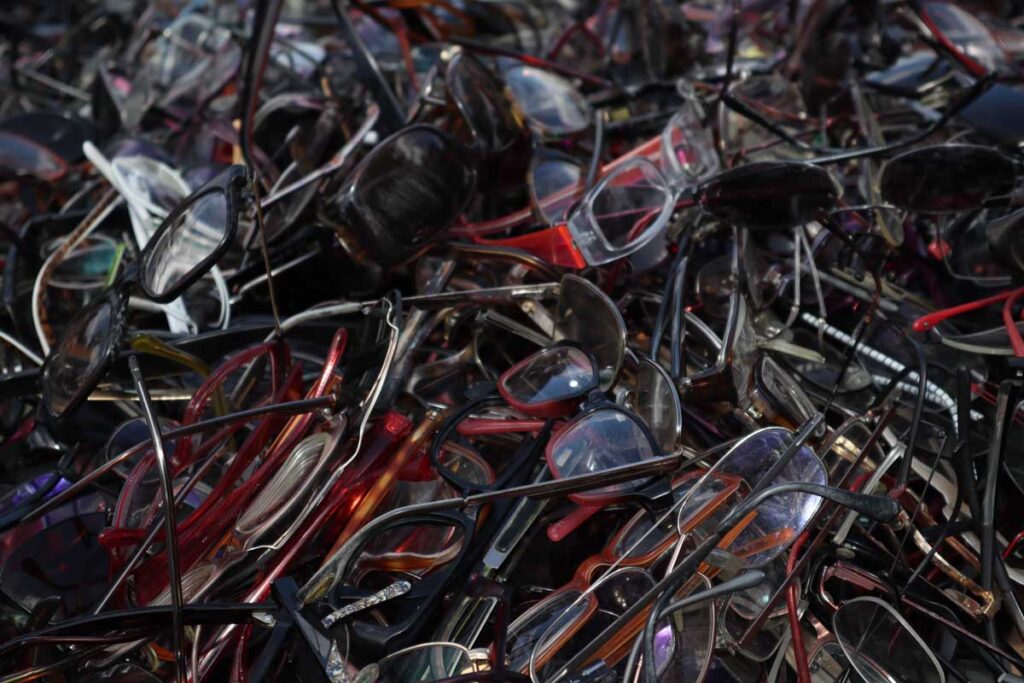With the new year upon us, it’s a perfect time to start decluttering! Today I’m going to share with you my simple guide and method of how to get rid of stuff. We regularly declutter throughout the year and have learned to stay on top of excess things. Many years ago, when we were in our camper full-time, we massively sized down and have stayed on top of it throughout the years now that we are a traditional home again. Nothing says peacefulness in the home like organization and cleanliness. In my experience, it is nearly impossible to achieve either, when you have too many things. Minimalist living is a trend that I believe is here to stay, so learning how to get rid of stuff is a crucial skill. It’s not just about cleaning your home, but also about making a conscious effort to reduce waste and being wise about decisions of what has earned a space in your abode. Today, I will walk you through various aspects of decluttering, making it a less daunting task for you to achieve this year and beyond.
Understanding the Need to Declutter
Before diving into decluttering, it’s a good idea to consider why it is a good idea to stay on top of your stuff. Our homes are often filled with items that we don’t use or need. These things not only take up physical space but also clutter our minds and rob our peace. The more stuff we have, the more time and energy we spend maintaining them. By decluttering, you can free up space, and reduce stress, which naturally leads to a more organized life.
The Benefits of Decluttering
- Less to Clean: When you have fewer things, you have less to clean, organize, and maintain.
- More Space: Decluttering helps you create more physical space in your home.
- Mental Clarity: A clutter-free space can bring mental clarity, reducing anxiety and stress.
- Saves Money: When you declutter, you are more aware of what you own, reducing the chances of buying duplicates.
- Helps Others: Many of your unused items could be donated to those who need them or appreciate them.
Preparing to Declutter
Before you start decluttering, it’s important to prepare yourself mentally for the process. Decluttering is not just about getting rid of stuff; it’s about making conscious decisions about what you want in your life.
Set Your Mindset
The first step is to set your mindset. Decluttering can be an emotional process. You might be holding onto things for sentimental reasons or because you think you might need them in the future. Both of these root issues can be fear-driven. It’s important to evaluate any barriers you have to getting rid of things.
One book that helped me with this immensely is Marie Kondo’s, Life-Changing Magic of Tidying Up. This book is over 10 years old, but she does a wonderful job of addressing the burden that excessive things (sentimental or not) cause on a home and mental well-being. As with any book, take her advise with a grain of salt. If you specifically struggle with fear or sentimentality, Marie Kondo’s book is EXCELLENT!
Define Your Goals
Having a clear goal can motivate you to declutter. Whether you want a cleaner home, more space, or a minimalist lifestyle, defining your goal will give you a sense of direction. One way to grab some inspiration and determine your goals for decluttering is to view images of homes that are clutter-free through simple internet searches.
Decide What to Keep
Decide on the items that you truly need, use regularly, and love. These are the things that add value to your life. Everything else is potential clutter.
Plan for the Unwanted Items
Before you start decluttering, plan what you will do with the items you decide to get rid of. You can sell the items at a garage sale or on Facebook Marketplace. Or if may want to donate, recycle, or dispose of them. Having a plan will make the decluttering process smoother. And the sooner you get the items no longer useful from your home, the sooner you will reap the rewards of your decluttering.

The Decluttering Process
Once you are mentally prepared and have a clear plan, you can start the decluttering process. Here are some strategies to help you efficiently declutter.
Start Small
Start with a small area like a drawer or a shelf. Once you see the progress you’ve made in that small area, you’ll feel motivated to tackle larger areas.
Use the Four-Box Method
The four-box method is a popular decluttering technique. Label four boxes: trash, donate, keep, and relocate. As you go through your items, place each item in one of the four boxes.
Follow the One-Year Rule
If you haven’t used an item in the past year, you probably don’t need it. This rule is especially helpful for clothes, shoes, and kitchen gadgets.
Consider the 80/20 Rule
The 80/20 rule states that we use 20% of our belongings 80% of the time. This means that the majority of the stuff we own is rarely used. Keep this rule in mind as you declutter.
Digitize When Possible
Digitizing items like photos, documents, and CDs can save a lot of physical space. Just make sure to back up your digital files. My preferred method for online storage is my Apple Cloud service, but there are plenty of storage services where you can maintain digital items and pitch physical copies.
Involve Your Family
If you live with others and they tend to be more attached to the things in your home, involve them in the decluttering process. This will not only make the process faster but also ensure that everyone is on board with the decisions being made.
Room-by-Room Decluttering Tips
Bedroom
- Make your bed before you start decluttering.
- Clear off your nightstands and dressers.
- Go through your wardrobe and get rid of clothes that don’t fit, are worn out, or that you don’t wear often.
- Don’t forget about shoes and accessories.
- Consider donating any clothing that is still in style to resale shops such as Clothes Mentor or Plato’s Closet
Kitchen
- Go through your kitchen cabinets and get rid of expired food and spices.
- Evaluate your cookware, bakeware, and utensils. Get rid of any duplicates or items in poor condition.
- Clean out your fridge and freezer.
Living Room
- Remove any items that don’t belong in the living room.
- Evaluate decorative items and keep only those that you love and add value to the space.
- Organize your entertainment center and get rid of any outdated media or games you no longer use or enjoy.
Bathroom
- Discard any expired medications, makeup, and personal care products.
- Evaluate your towels and bathmats. Get rid of any that are old or worn out.
- Organize your toiletries and get rid of any items you don’t use.
Office
When decluttering your office, start by clearing off surfaces and putting away anything that doesn’t belong. Next, go through any paper items and sort them into “File,” “To-Do,” and “Trash” piles. Finally, get rid of any old or unused electronics and chargers.

Closets
Remove everything from closets and get rid of any items that are excessive, unusable, or haven’t been used during the past year. Incorporating bags, (such as these ones for large items such as spare comforters and pillows) that are labeled are helpful to declutter and organize an often messy area of the home.
Kids’ Rooms
For kids’ rooms, consider hosting a toy swap with friends or neighbors. Alternatively, you can donate gently used toys, books, and clothes to local schools, libraries, or charities. As for old baby gear, consider bringing items to resale shops or donating to a local shelter or community outreach center.
Donating, Selling, and Recycling Unwanted Items
Once you’ve decluttered, it’s time to get rid of the stuff. Depending on the condition and type of item, you can donate, sell, or recycle it.
Donating
Donating is a great way to give your unwanted items a second life. Many charitable organizations accept donations of clothing, furniture, books, and household goods.
I have an extremely hard time throwing things away. If this is also your bend, consider whether an item is truly useful or past its life. I have to evaluate this throughout the decluttering process. One thing that is helpful to remember is that donated items that are unusable become someone else’s burden to pitch in the garbage. So be sure to donate usable items. Also, you may want to consider getting a charitable donation receipt for tax deduction purposes.
Selling
If you have items that are in good condition and have value, consider selling them. You can sell items online through sites such as eBay, Craigslist, or Facebook Marketplace. Another option is to drop your items off at a consignment store or resale shop. You can also hold a garage sale, just be sure to store items out of the way until garage sale season arrives.

Recycling
For items that are broken or worn out, recycling might be the best option. Many cities have recycling programs that accept a wide range of items, including electronics, appliances, & clothing. For an exhaustive list of recyclable items and ideas on how to recycle them, check out this link from the EPA.
Disposing of Specialty Items
When it comes to decluttering, some items require special consideration. Here are some tips for getting rid of specialty or collectible items:
- Books: Consider donating used books to your local library or selling them at a garage sale or used bookstore. Another option is to sell your books online. One site I’ve been exploring is Bookscouter.com, which scans multiple buy-back online stores for the best price.
- Electronics: Many electronics retailers and cellular carriers have recycling programs for old devices. You may also consider buy-back sites such as Smart Phone Recycling.
- Furniture: Sites such as Facebook Marketplace, or Craigislist are great for reselling. You may also want to consider donating your used furniture to a local charity or thrift store.
- Eyeglasses: Old eyeglasses can be donated to organizations like the Lions Club or dropped off at a participating Walmart Vision Center.

- Professional Clothing: Organizations like Dress for Success accept gently used professional clothing and distribute it to those in need.
- Prom Dresses: Organizations like Becca’s Closet accept new or lightly worn prom dresses and distribute them to high school girls who cannot afford them.
Maintaining a Clutter-Free Space
Once you’ve decluttered, the challenge is to keep your space clutter-free. Here are some tips to help you maintain your newly organized space.
- One in, One Out Rule: For every new item you bring into your home, get rid of an old one.
- Regular Decluttering: Set aside time regularly to declutter. This could be once a week, once a month, or once a season.
- Mindful Shopping: Be mindful of what you bring into your home. Ask yourself if you really need the item and where you’ll keep it.
- Organize: Keep items organized so that everything has a place. This will make it easier to keep your space tidy.
Conclusion
Learning how to get rid of stuff is a process. It requires time, patience, and a willingness to let go. However, the benefits of decluttering extend beyond a clean, organized space. It can also lead to a more peaceful and present lifestyle. No matter where you are in the decluttering process, just remember to take it one step at a time, and soon, you’ll enjoy the peace and satisfaction that comes with a clutter-free home.
As an Amazon Associate, I earn from qualifying purchases at no extra cost to you. Thank you for your support!

1 thought on “How to Get Rid of Stuff – Complete Guide”